Examining A Practice's Vision Can Help Ensure Success
Whether via enhanced digital diagnostic imaging, improved ergonomics, or the help of artificial intelligence, devising a clear plan can lead a practice to success.

Perfect Vision is 20/20, as the saying goes. Not only does it allow for reflection of past performances, but it also presents a new, unique perspective and gives us insight and understanding. Vision is key when planning for the future. Every dental practice requires a well-thought-out plan. Proper vision as a concept in the dental practice can provide a clear path forward and correct common problems the practice faces.
You need to understand your business’s core vision,” Jeremy Krell, DMD, MBA, a health care entrepreneur and a member of the board of advisers for Denti.AI, says. “That vision guides the way you market, the way you expand, the types of people you hire, and the policies you have inside your organization.”
A practice’s conceptual vision statement should build off the work of Stephen R. Covey’s book The 7 Habits of Highly Effective People and “begin with the end in mind, ” according to Mark Hyman, DDS, MAGD, an adjunct full professor and special assistant to the office of the dean at University of North Carolina (UNC) at Chapel Hill Adams School of Dentistry and an international speaker. “Creating a vision requires having a deep understanding of your goals, your values, and your mission in life that provides a basis for everything else.”
Dan Traub, vice president of product at Method Procurement, agrees, adding that dentistry is a team sport. Moreover, he says, having the team aligned with the goal of entrepreneurial success can fuel a practice’s growth.
“Having a well-run business that has the financial means [that you] keep the door open and invest in technology and education to pursue that goal. If you have a well-run business, you will be able to make those types of investments,” Traub says.
Setting the Practice’s Sights
Roy Fried, territory manager for A-dec in Minnesota, North Dakota, and eastern South Dakota, has worked with the company for 22 years and has been in the dental field for 30 years. He breaks down the importance of vision for a practice into 3 areas:
1.Eyesight: Having good sightlines into patients’ mouths when delivering care is vital to a dentist’s career longevity.
2.Insight: Using technology such as imaging and other diagnostic tools allows dentists to look further into a patient’s body to assess health in ways that they could not before.
3.Foresight: Creating a vision for their practice for 2, 5, and 10 years out is vital for success.
Although all 3 areas are crucial, Fried says, foresight has the most significant influence on business success. “Unless you have a clear picture of the business aspect and what patients focus on, you may not be drawing the patient base you want,” he says.
“You need to have the vision of where the practice is going to ensure that the tactical decisions along the way are in support of that vision,” Mark Greenwood, vice president of imaging product development at Midmark, agrees.
When designing an operatory such as this one from Midmark, it is important to think about who will be working in the space and how they like to work so no one is forced to repeatedly bend and twist while providing patient care.
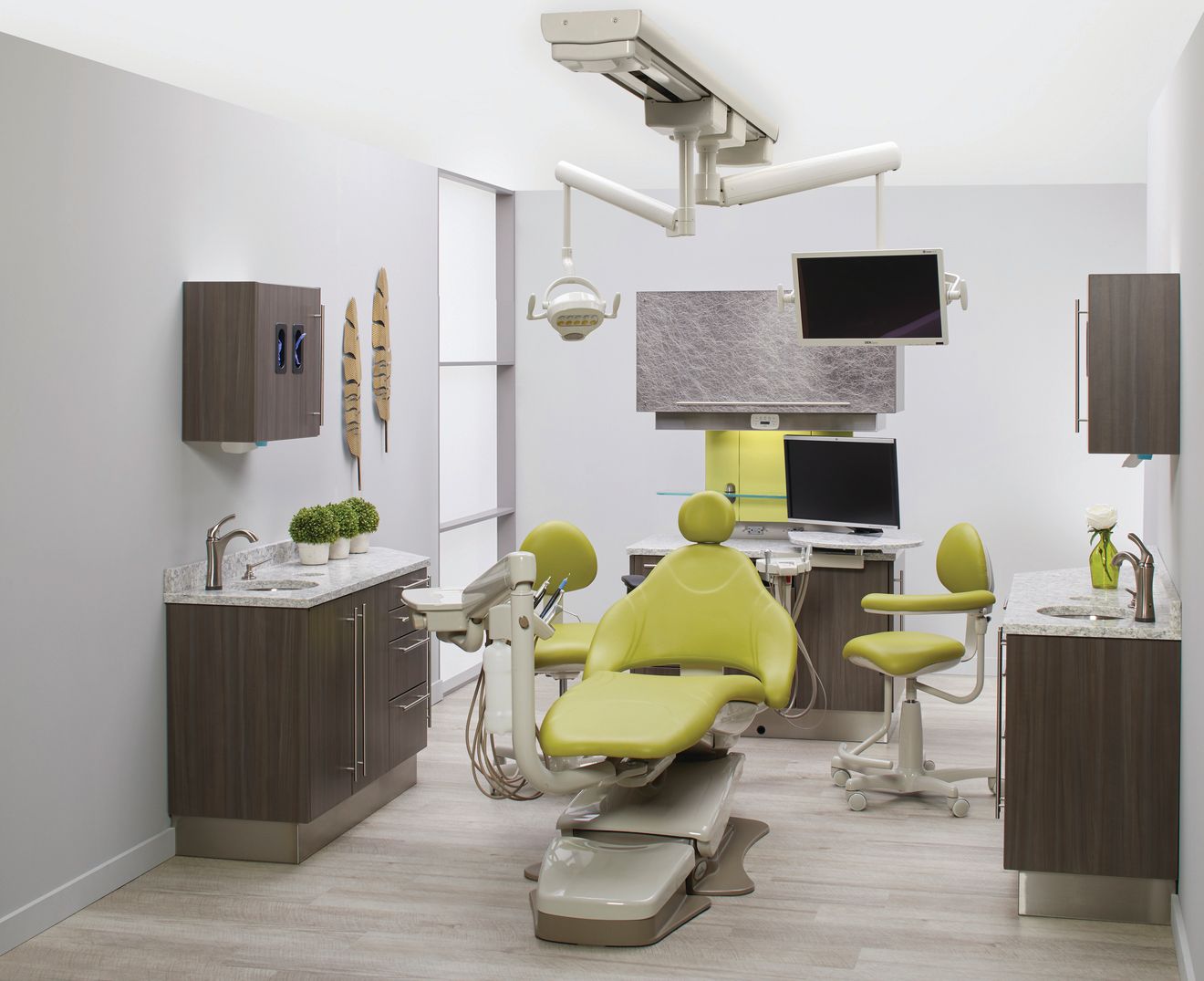
Patients’ needs should also be a part of a dental practice’s conceptual vision. Brian Connolly, vice president of business development Americas at Medit, thinks patients are more involved in dentistry today than they were in the past. Lack of consideration for what patients want and what makes them comfortable accepting treatment could prevent them from returning to a practice, he says.
“From a patient experience perspective, dentistry has always been about ‘This is what you need,’ coming at the patient from a clinical standpoint instead of approaching them more personably,” Connolly says. The issue should be stated “a little differently and through a patient lens,” he adds.
As continually changing and improving technology drives the motivation of many dental practices, Dr Krell believes taking courses, trying new things, and keeping current are critical to providing the best patient care. “You should be thinking about how to create a tech-forward and evidence-based-medicine practice,” Dr Krell says. “We all have a duty to keep up-to-date with current technology.”
The PreXion 3D Excelsior is a 3D CBCT imaging system designed to provide incredibly sharp and accurate images with fast scan times available for a wide rage of applications.
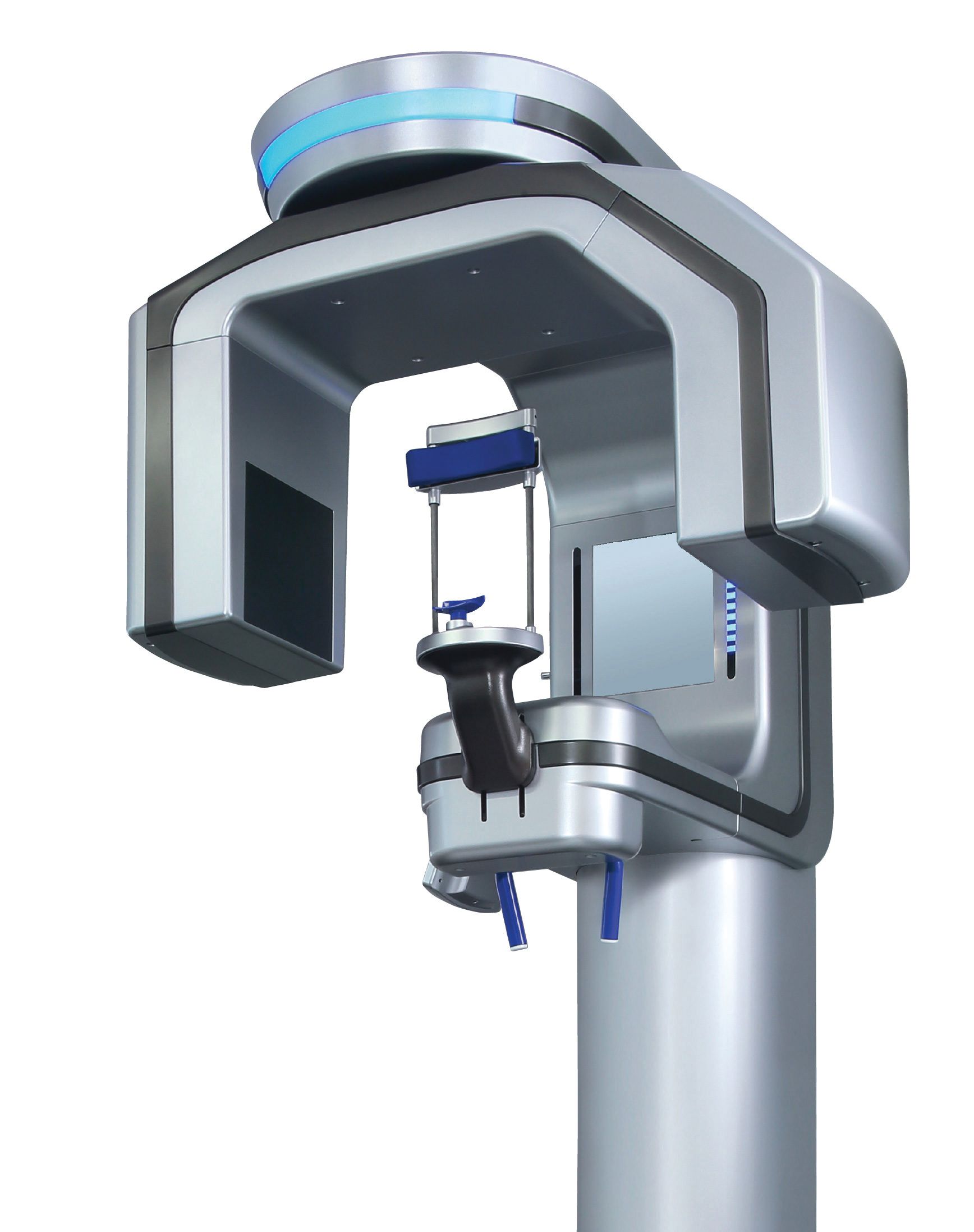
“No matter what happens with technology, the vision helps practices get to where they want to be. Technology can help with the vision, but the vision needs to come first,” says Rob Gochoel, vice president of sales for PreXion, a manufacturer of 3D cone beam CT (CBCT) imaging systems.
Pearl’s CEO, Ophir Tanz, says each dental practice is like its own fiefdom. Some dentists have ambitious plans to launch dozens or even hundreds of offices, whereas others aim to pursue education or be a thought leader. As an entrepreneur, first leading computer vision start-up GumGum and then Pearl, which he spun out in 2019, Tanz understands the importance of methodically working toward a long-term vision or goal for a business.
“It doesn’t have to happen overnight,” Tanz says. “But having a clear end goal in mind operates as a North Star—a reference point that helps you keep your focus on the larger objective and makes every day more meaningful.”
Correct Vision Problems
Without a clear vision, it is easy for a practice to get lost. Many practices get overly detailed when describing their vision, making it difficult to achieve. Although concrete steps help make an idea actionable, getting too specific leads to a checklist instead of a vision statement, according to Dr Krell. “You have to aim down the middle to best summarize your objectives and key results succinctly,” he says.
“They try to make the vision statement too specific or too broad,” Gochoel agrees. “If you make it too specific, you might not ever reach it or find that you are disappointed with the results. And if you make it too broad, it won’t differentiate you from other practices out there.”
Clearly, having a vision for the practice is excellent, but what actions ensure making it happen? How do practices avoid losing sight of the goal? Here’s what we learned about correcting business-related vision problems and producing visible results.
Include the Team in the Process
Anybody can buy technology, Dr Hyman says, but how it is applied and how the team is trained make all the difference. The work of business author Tom Peters shows that without a great place to work, “all this stuff that you buy is worthless,” Dr Hyman says. “You can invest in CAD/CAM, cone beam, digital printers and say you want to be the high-tech leader in your community,” he says, “but what good does it do if you have a lousy place to work? You’ve got to take care of your team first.”
Dr Hyman and his team determined what it means to be a part of the “practice family.” The particulars ranged from being on time and present at work to mandating patient education for every procedure and providing comfortable financial arrangements for every treatment.
Along with involving the team members with creating the vision, Dr Hyman ensured their financial interest in its success by extending profit sharing to the team and maxing out his contributions to their 401(k)s. Many of his employees were with him for several decades and retired with 6-figure retirement accounts.
Dr Hyman credits consultants and other thought leaders in the industry and the strategic coaching they provided him along the way for his team’s success. He recommends dentists struggling with this side of the business consider coaching to help them with their vision strategy and keep in mind the continual nature of change.
“If you don’t know how to articulate the vision for the practice, you have to put your handpiece down, meet with the team, and create it, and realize that it’s a living document,” Dr Hyman says. “It gets revisited because as you and the world and your teammates change, you adjust the vision.”
The best part of the process is that as the profitability explodes, practices can invest in technology such as CBCT, intraoral cameras, CAD/CAM, and 3D printers, Dr Hyman says. In other words, he says, it’s not about the technology purchased; it’s about the effort put into the team. Moreover, team members who are excited and enjoy what they are doing don’t have to be pushed. “They join you in vision to be successful beyond anything you ever imagined,” Dr Hyman says.
Take a Farsighted Approach
Fried identifies poor ergonomics as a significant mistake dentists make regarding long-term career vision. Repeatedly working in a position without minding the ergonomics can lead to injury and shorten a dentist’s career. Fried says 30% of dentists who retire early do so because of physical disabilities acquired because of poor work-related ergonomics.
Designed to help clinicians get a better line of sight to the tooth being treated, the A-dec Dental Angles of Access app helps determine the optimal place to sit in an operatory to have the best access to the patient’s tooth currently being treated. It takes into account chair position, patient position and clinician position to map out where the clinician should be sitting to have the best view and access.
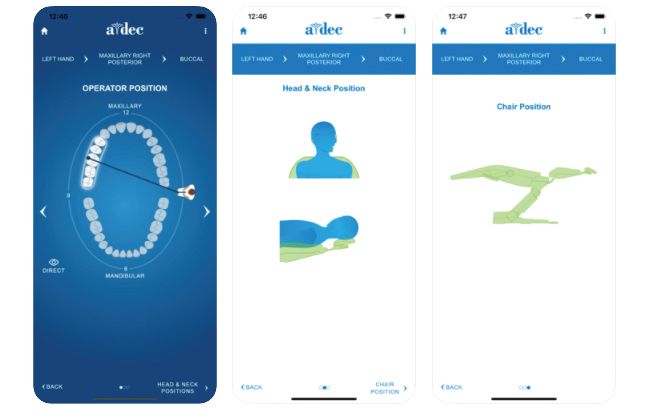
A-dec’s Angles of Access, available for Android and iOS devices, and complimentary continuing education (CE) training by territory managers can help with ergonomics. The free application allows dentists to choose the tooth and surface they are working on and then see how to obtain the best view of that tooth surface. “It will show them not only where to sit alongside the patient to have better posture but [also] how to adjust the back and headrest of the patient’s chair to get the tilt of their head just right so you can look right down at the tooth surface,” Fried says.
Another common mistake Fried sees in practices involves not listening to the dental team—specifically, the dental assistant—when designing treatment rooms and other practice workflows. “The assistant in work-motion studies does about 80% of all the motion in the dental treatment room,” Fried says. “If the assistant isn’t productive, now you have a dentist that isn’t productive.”
A-dec incorporates dental assistants into the design plan to learn where the current layout restricts the flow and causes a bottleneck. Fried says the company also considers how the office delivers patient care, because a side-delivery system needs different dimensions than a rear-delivery one, along with workday details such as the desire to incorporate CEREC chairside or have the option to stand up while providing care.
“Unless you ask these pertinent questions, you might end up with some nice equipment that doesn’t serve the dentist that purchased it, and we hope to prevent that,” Fried says.
Fried also believes dentists should think about the longevity of their tools. Most of the equipment A-dec makes is designed to last for 20 years of service, he says. “That’s important because dental professionals have to think about their health,” Fried explains. “Make sure you’re getting advice on how to get that right solution for you.”
Don’t Lose Sight of the Vision
Dental practices should always consider how short-term tactical decisions affect overall vision, according to Greenwood: Every choice regarding office layout, staffing, and equipment purchases should be in harmony with and directly support the practice’s vision.
For example, before taking on same-day restoration capabilities, the office should consider whether the practice has room for the workflow required, trained staff to manage the process, and the equipment and accessories to support that offering.
People can help in that regard, Greenwood says. He recommends getting a combination of input from outside sources, especially seeking advice from peers at a practice the dentist wants to emulate. External consultants and manufacturers can help, too.
“Because Midmark does extensive usability testing and research into customer needs, we as manufacturers can use the knowledge and expertise to help practices choose the technology and design the workflow needed to achieve their vision,” Greenwood says.
Midmark also offers Impact Design courses in which peers and thought leaders get together to share how they look at practice design and visions. “Through these consultations, we can help dentists realize their vision while understanding how decisions that they make along the way all [affect] each other,” Greenwood says. “The more data points the dentist has, [the more it] helps ensure the best decisions.”
Develop X-Ray Vision
Radiology is a bit disjointed in the dental industry, according to Dr Krell. Clinicians have variable levels of training and could miss some findings. Preferences also differ for which x-rays are needed and how often and for types of imaging, such as scanning or 3D imaging.
Then the various systems and software need to interconnect and function together. Finally, the images must end up in the patient record, but many times they don’t or aren’t easily accessible or reviewed, so the chart is incomplete.
Denti.AI’s image analysis software is designed to automatically detect potential carious lesions. It uses machine learning and artificial intelligence to identify the suspicious areas on a patient’s x-ray that could be carious lesions or other issues.
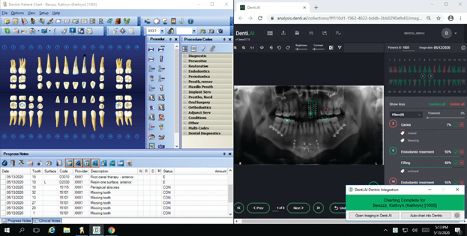
To help solve some of these problems, Denti.AI developed and patented a streamlined tooth numbering and automatic charting functionality. Denti.AI can also identify the essential findings radiology usually reveals, including caries, periapical lesions, bone loss, past restorative work, and missing teeth. Three clinical studies, from UNC, the University of Louisville in Kentucky, and Indiana University, validate these capabilities.
Also, the Denti.AI team focused on providing an experience that fits seamlessly into the workflow, which Dr Krell credits to their partnerships. Because using a new technology such as artificial intelligence can provoke fear, Dr Krell believes if the technology didn’t offer an ideal experience, a dental practice wouldn’t use it. He thinks it is essential to emphasize that AI is a tool, and the control remains in the dentists’ hands.
“This technology is going to highlight areas for dentists, and dentists can approve or disapprove,” Dr Krell says. “This is here to help us catch things that we may miss.”
It is also essential that a practice consider the technology available, the people who will use it, and how well it will fit in the practice’s environment, according to Dr Krell; having new technology that people will use is half the battle, he says.
He also advises being guided by evidence-based medicine, not unfounded marketing claims, to find tried-and-true tools reviewed by key opinion leaders and experts globally and not “fall into a marketing trap.”
“The last thing is, you have to try stuff. Approach it with an open mind, and try it out,” Dr Krell says. “What I don’t want people to do is try 1 thing, not like it, and then give up on the whole sector of innovation. I think that is a mistake, and you could miss out on something there.”
Watch the Purchasing Process
Many practices do not have a process for procurement, Traub says, but overspending on supplies leaves opportunities on the table.
Moreover, with the coronavirus disease 2019 pandemic wreaking havoc on many practices’ bottom line, with less production and more infection control costs, it is more essential than ever to manage expenses.
Method Procurement provides a software subscription that supports a complete inventory, purchasing, and spend management process for the needs of dental practices, which often drives value to the bottom line even faster than added production can, Traub says.
Presenters at dental conferences generally emphasize building a standardized and repeatable process, Traub says, adding that it’s even better to create a strategy that team members can run consistently on their own. He says Method facilitates this by providing data and insight into current dental supplies and supplier relationships: “We like to tell people that it is an alternative to growing production and that 2020 is a perfect time to control expenses.”
Traub says most dental practices increasingly require the support of multiple suppliers, creating a more complex situation to manage. Method’s software offers a clearer picture of buying behaviors regardless of supplier.
A practice’s process can be optimized with formularies for preferred products and pricing or software that highlights pricing increases from specific suppliers, which guides exploring opportunities to negotiate a new price. The crucial factor, Traub explains, is having the data available to make these types of decisions.
“There are a thousand different things data can help with,” Traub says. “It’s tough to manage what you can’t measure.” He encourages practices to devise a well-managed path to profitability and be able to compare expenses against a budget.
“If you have a vision of a certain level of profitability, you need to work backward from that,” Traub explains. “Expense control is a key part of making sure you reach those goals.”
Enlist a Second Set of Eyes
Technology is an augmentation of human limbs and capabilities, Tanz says. Telescopes allow seeing farther; hammers enable hitting harder. He thinks the most impactful form of vision in 2020 is computer vision, which gives practices the ability to deploy a second set of eyes to peer into data sets and add value.
Pearl has been collecting what Tanz describes as the most extensive collection of dental-labeled radiographs and oral scans in the field. The company uses them for training machine-learning models to identify pathologies with a high degree of precision and categorize the quality of past tooth preps, margins, and scans that dental professionals produce.
Pearl also works with original equipment manufacturers to incorporate the platform into x-ray sensors and into practice management systems. Pearl also has a carrier business that automates claims and reviews and identifies fraud, waste, and abuse.
“We believe that every office in the world should and will, in relatively short order, incorporate these capabilities as part of their standard of care. We intend to make it very accessible and cost-effective so that it can add value to practices of all shapes and sizes,” Tanz says.
Bringing AI into the dental workflow is a low-risk, high-reward proposition for practices, particularly individual practices, according to Tanz. He says that AI capabilities can be seamlessly integrated with a practice’s existing infrastructure stack.
Moreover, he says that Pearl’s Second Opinion product, which provides pathology analysis, and Practice Intelligence, which analyzes historical practice performance and recommends training and education opportunities based on the records it evaluates, deliver value on day 1 without being cost-prohibitive.
“You can push a button, and these capabilities turn on. You don’t have to invest in expensive software or make a long-term commitment,” Tanz explains. “If you are unhappy with the quality of service, you can cancel it.”
Transparency and consistency, alongside a range of tactical features and functionality, create a superior baseline for care moving forward, according to Tanz. “You always have this second set of eyes helping you along,” Tanz says. “It’s like having another dentist by you 24/7 and on-demand.”
Focus on Full Comparison, Usability, and Trends
Connolly notes that in his experience, dentists often receive a limited scope of input when converting a practice from analog to their vision of digital dentistry. Without considering the total offering, practices don’t have enough information to make the best decision for their workflow. Moreover, Connolly says, sometimes dentists regard a new product as “just another one of those new toys” without considering how it may be different and can help provide a clear solution for the patient.
“It also comes back to asking yourself the question ‘If I invest in this tech, will it allow me to have a better dialogue with patients to accept the treatment plan I recommend?’” Connolly says.
In addition to contemplating how a technology can improve the patient interaction and treatment outcomes, dentists should consider usability to spur adoption of the technology into the practice, Connolly says. It is best to implement tools the clinician understands to best enhance daily use, such as comparing enamel wear on an arch, doing an orthodontic simulation, or crafting a smile design. These functions are part of Medit’s new i500 intraoral scanner, which is built on an open system, he says.
“These added apps are useful for dentists to have a conversation with patients,” Connolly says. “Some of the other technologies in the marketplace are more specific, meaning designed only for ortho or crown and bridge. The i500 is a product that is a more diversified communication tool.”
Connolly sees a trend toward patient-focused treatment, accelerated by new direct-to-patient services recently launched in large retailers. He sees the potential for clinicians to capitalize on that trend by enticing that part of the patient population to come to the practice rather than going to, say, a Walmart store. Communication tools built into the Medit software allow sending information directly to the patient.
“When a patient feels they are part of the solutions and not just given the answer, there is a higher buy-in to the treatment plan,” Connolly says. “By opening up the opportunity for the patient to be part of designing the solution, which is a trend today, practices can benefit.”
Enable Patient Vision: Seeing Is Believing
When dentists do a better job of diagnosis and presenting treatment plans with options, Gochoel says, patients feel more comfortable moving forward. PreXion’s 3D imaging allows the doctor to see more and see it earlier. Gochoel says one of PreXion’s key opinion leaders always shares the scans and explains the images to patients. Gochoel estimates that the national treatment acceptance rate is 3 or 4 of 10 patients, but this dentist’s rate is closer to 80%.
“It enables the office to not only provide better dentistry but also to engage with the patient,” Gochoel says.
The new PreXion 3D Explorer takes a large field of view, 15 by 16 cm, which Gochoel says provides a much more complete oral cavity analysis. “[Dentists] often see in the CBCT image what the patient is already telling them about their sleep,” Gochoel says about dentists performing sleep consultations using 3D Explorer imaging.
“Do your homework,” Gochoel says. “There is always more out there than you think there is.”
Although that step can be tedious, he says, it is essential because there are many aspects to understanding imaging technology. Also, be aware of any associated fees, such as for software licenses, software upgrades, or additional staff training. “We don’t charge for those, but some of our competitors do,” Gochoel says. “Homework will help you make a side-by-side comparison.”
For dentists who have never had a CBCT and are in the market for this technology, Gochoel advises talking to someone who uses it and asking about the pros and cons. The information can help guide the conversation during meetings with suppliers.
Have a Vision for Training
Sometimes a vision must be changed. Midmark recently shifted its Impact Design dental practice design seminar series from in-person to online due to the coronavirus disease 2019 (COVID-19) pandemic.

Greenwood has 30 years’ experience in imaging, and a common mistake he sees involves a lack of training for the office staff. According to Greenwood, Midmark has emphasized training with their acquisition of the True Definition scanner last year and the development of their Extraoral Imaging System CBCT scanner, which they will launch in early 2021. Both units have dedicated training teams that educate the dental practice on how to obtain the most precise possible image of the anatomy.
“It’s making sure that the team can fully utilize the unit that they’re purchasing and the staff is completely comfortable using it,” Greenwood says.
Gochoel agrees that training is essential to get the best usage out of a technology investment: Nobody wants to buy a computer for just 1 function—they want to use all the programs and software; it’s no different with dental technology.
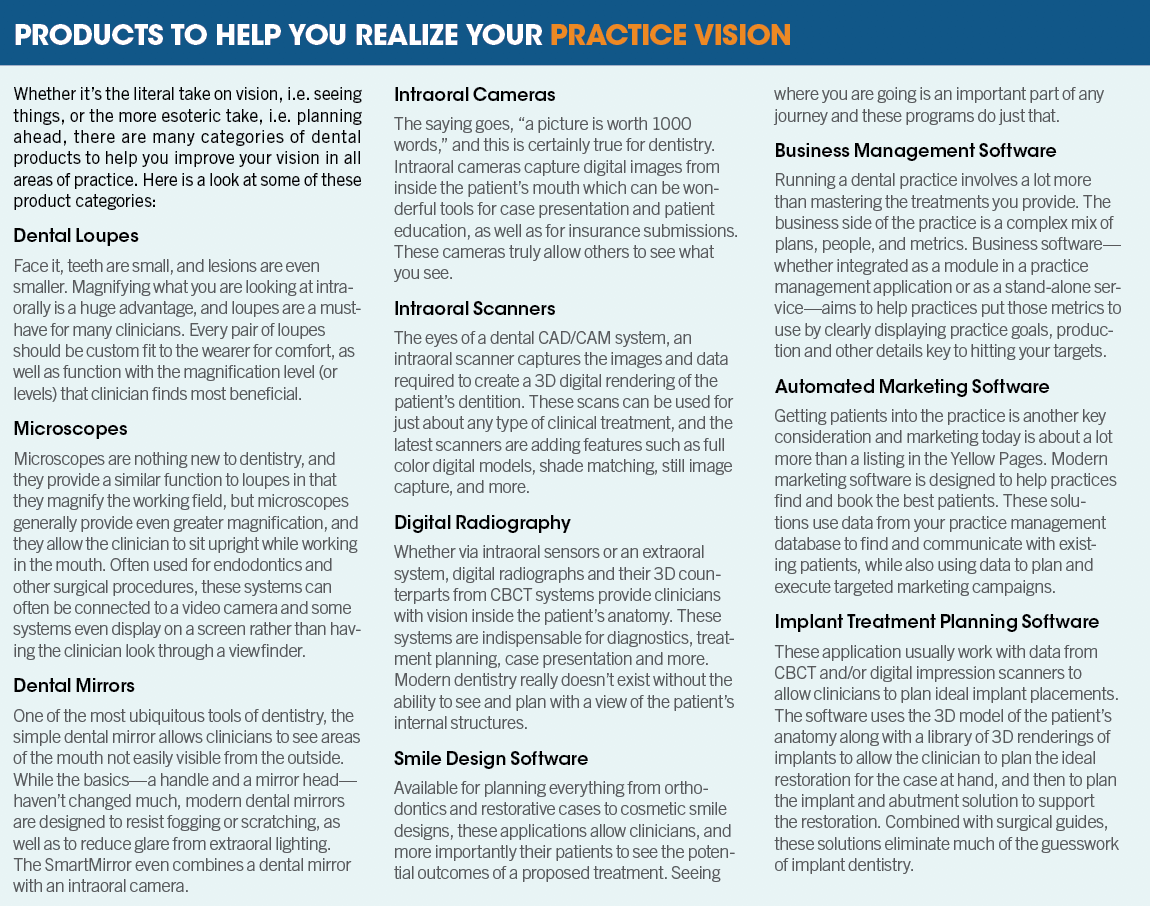
PreXion offers free in-office radiology education when a dentist purchases a system. In addition to the initial training, PreXion provides 8 additional hours of CE education from CBCT Readers for the dentist to take at their leisure and scan interpretation education reports from an oral maxillofacial radiologist. The radiologist will also send back their interpretation and diagnosis of the scan and treatment recommendations, typically within 1 or 2 business days.
“One of our visions has always been to grow the market through better education of the profession. This training partnership goes hand in hand with that strategy,” Gochoel says. “It can provide the dentist that peace of mind in terms of the diagnosis, as well as provide that second opinion, which will be so valuable, especially when the dentist starts taking those first images.”
Greenwood recommends researching the training options when looking to buy imaging equipment. Whether that means purchasing an extra service, making an arrangement with the manufacturer’s representative, or taking a CE course, training is imperative.
“Make sure the staff is knowledgeable about the equipment and applications,” Greenwood says. “With dental imaging, there’s the technology that underlays the use of that product, and the more that they understand how it works and why it works, [the more] it helps them use the products as fully as possible.”
Furthermore, dentists should choose equipment the practice can take full advantage of, Greenwood says. It should be intuitive and easy to learn. He compares it to following a weight-loss plan.
“The best diet is the one you can stay on,” Greenwood says with a laugh. “It’s not one-size-fits-all when it comes to diets, and neither is dental imaging equipment. The best product is the one that you’re going to use the most. Easy-to-use products that the staff can quickly learn to use are the most valuable.”
